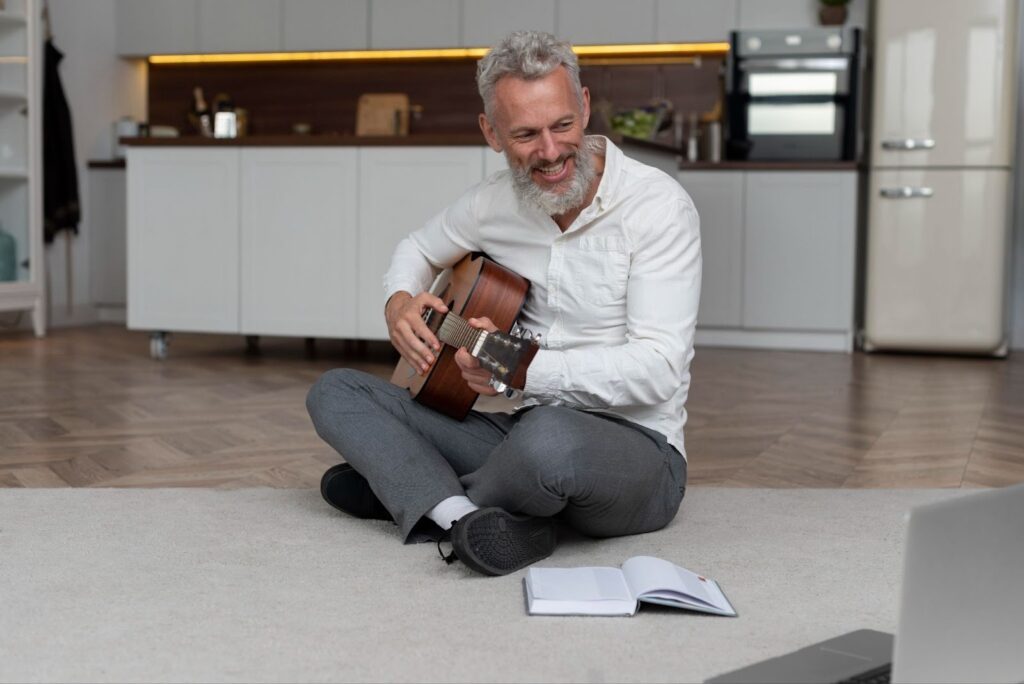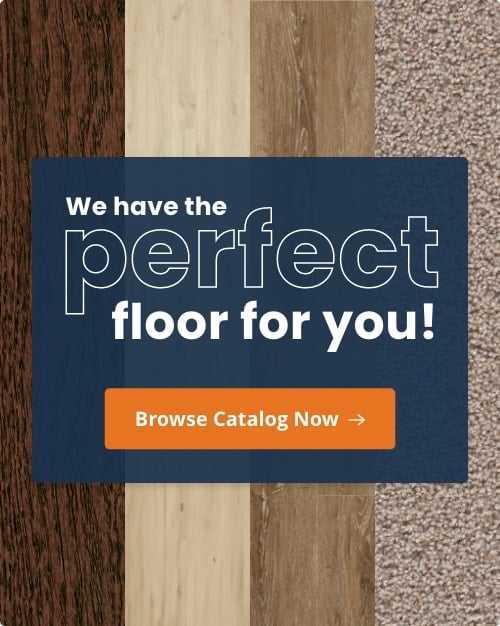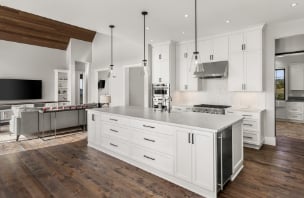

Every year, thousands of older adults take a tumble in the one place they should feel safest: their own home. Falls are the leading cause of injury among seniors, and flooring often plays a bigger role than most people realize. A shiny tile, a slippery rug edge, or an uneven threshold can turn a simple walk to the kitchen into a serious accident.
The good news? Safe flooring doesn’t have to look boring or “clinical.” Today’s materials are designed to be both practical and beautiful, offering traction, comfort, and warmth without compromising style. Think of soft, natural cork that cushions every step, sleek luxury vinyl that mimics wood without the slipperiness, or rubber flooring that’s as modern as it is secure.
The goal is simple: a home that looks inviting, feels comfortable underfoot, and lets you move with confidence. Because your floors shouldn’t just match your décor, they should help you live safely and gracefully, one step at a time.
Why Flooring Matters More Than You Think
It’s easy to overlook what’s right under your feet. But for seniors, flooring can make the difference between feeling steady and taking a dangerous fall. Every surface in your home plays a role in how safely and comfortably you move around. From slippery tiles to uneven thresholds, the wrong flooring choice can quietly increase your risk of accidents without you even realizing it.
Want to know if your flooring might be working against you? Do a quick safety check:
- Do you notice any slick or shiny spots when the floor is wet?
- Are rugs or mats curling at the edges or sliding around easily?
- Do your feet or knees ache after standing on a hard surface for too long?
- Are there raised thresholds or sudden height changes between rooms?
- Do you feel joint discomfort or fatigue after standing for long periods?
You can also check this out: Find Your Floor Style Quiz
If you said yes to even one of these, it might be time to rethink what’s beneath your feet. A few smart flooring updates can make your home not just safer but more stylish and comfortable, too.
Encourage family members to walk through the home with you. Fresh eyes can catch potential hazards you might have overlooked.
The Anatomy of a Safe Floor
Not all floors are created equal, especially when it comes to safety. The right flooring should do more than just look good; it should help you stay steady, supported, and comfortable with every step. To find the perfect balance between safety and style, it helps to understand what really makes a floor “senior-safe.”
1. Traction
When you hear “slip-resistant,” think of how much grip your flooring gives your shoes or bare feet. This is often measured by something called an R-rating; the higher the number, the more traction the surface provides.
For homes with seniors, aim for a moderate to high rating (R9 to R11). In simple terms, this means the floor helps prevent your feet from sliding, even if there’s a bit of water or moisture. Textured finishes, matte coatings, and softer materials like cork or rubber naturally offer better traction than glossy tiles or polished stone.
2. Transitions
Ever catch your toe on the edge where one room meets another? That tiny ridge or uneven spot is called a transition, and it’s one of the most common culprits behind home falls. Even a half-inch height difference can throw off your balance or catch a walking aid.
The fix is simple: use low-profile transition strips, keep flooring heights consistent between rooms, and choose smooth edging that helps you glide from one surface to the next without a second thought.
3. Comfort Underfoot
As we age, our joints become more sensitive to impact, so walking or standing on hard floors for long periods can cause pain in the knees, hips, or lower back. That’s where comfort underfoot comes in.
The best senior-friendly floors offer a bit of give, like cork or rubber, without feeling too soft or unstable. You want that just-right blend of cushioning and firmness that absorbs shock but still supports balance.
A safe floor isn’t just about avoiding slips, it’s about creating a surface that moves with you, supports your body, and gives you the confidence to stay active at home.
Top Flooring Options for Senior Safety (Ranked & Compared)
Choosing the right flooring isn’t just about looks, it’s about creating a space that feels secure, easy to maintain, and comfortable every step of the way. Some materials simply outperform others when it comes to traction and cushioning, so let’s break down the best options for senior-friendly homes.
Here’s a quick comparison at a glance:
| Flooring Type | Traction | Comfort | Maintenance | Style | Best For |
| Cork Flooring | ⭐⭐⭐⭐ | ⭐⭐⭐⭐ | Moderate | Warm & natural | Bedrooms, low-moisture areas |
| Luxury Vinyl Plank (LVP) | ⭐⭐⭐⭐ | ⭐⭐⭐ | Easy | Sleek & modern | Kitchens, hallways, living areas |
| Rubber Flooring | ⭐⭐⭐⭐⭐ | ⭐⭐⭐⭐⭐ | Easy | Contemporary | Bathrooms, entryways |
| Textured Ceramic Tile | ⭐⭐⭐ | ⭐⭐ | Easy | Classic | Bathrooms (with mats) |
| Low-Pile Carpet | ⭐⭐⭐⭐ | ⭐⭐⭐ | Moderate | Cozy | Bedrooms, lounges |
Cork Flooring
If you’re looking for something soft, warm, and sustainable, cork flooring checks every box. It naturally cushions your steps, absorbs sound (goodbye echo!), and provides gentle traction that makes walking easier on joints. Its subtle “bounce” makes it ideal for bedrooms and areas where you’re on your feet often.
Downside? Cork doesn’t love moisture. Without proper sealing, it can swell or stain when wet, so keep it away from bathrooms or laundry rooms. Still, it’s a beautiful, comfortable, and green choice for calm, cozy spaces.
Luxury Vinyl Plank (LVP)
Luxury vinyl plank has become the go-to choice for many homeowners, and for good reason. It’s durable, waterproof, and designed with slip-resistant textures that mimic real wood or stone. The best part? It’s easier on the budget and simple to clean.
LVP’s low-profile design means smooth transitions between rooms, reducing trip hazards. It’s stylish enough for open living areas but practical enough for kitchens and hallways where spills happen.
Rubber Flooring
When it comes to traction, nothing beats rubber. It’s soft, springy, and built to absorb impact; no wonder it’s used in gyms and hospitals. Modern versions come in sleek, home-friendly designs and colors that blend beautifully with contemporary interiors.
Rubber flooring also offers incredible comfort underfoot, making it ideal for spaces where stability and shock absorption matter most, like bathrooms and entryways. The only catch? It can be pricier than vinyl, but the safety benefits are well worth it.
Honorable Mentions
Not every senior-safe flooring option needs a complete remodel. Sometimes, the best solutions come from tweaking or upgrading what you already have. These materials may not top the list for every room, but they’re worth considering, especially when chosen and installed with safety in mind.
Textured Ceramic Tile
Ceramic tile has long been a favorite for its timeless look and incredible durability. It stands up to moisture, spills, and scratches, making it a go-to for kitchens, bathrooms, and entryways. But here’s the catch: smooth or glossy tiles can turn into ice rinks when wet.
If you love the clean, polished look of tile, opt for textured or matte finishes designed with a higher slip resistance (look for an R10 rating or above). You can also boost safety by:
- Using grout lines or smaller tiles to increase traction.
- Adding anti-slip coatings or rubber-backed mats in key areas like near sinks or showers.
- Keeping tiles level with adjacent flooring to avoid toe-catching edges.
With the right texture and finish, ceramic tile can give you the best of both worlds with sophisticated style and dependable safety.
Low-Pile Carpet or Carpet Tiles
Carpet may not seem like an obvious choice for senior homes, but it offers something most hard floors can’t: gentle cushioning that protects against falls.
Low-pile carpets (with short, dense fibers) provide grip underfoot and help soften the impact if slips do happen. They’re also a great option for bedrooms and living areas where comfort matters most.
However, the trick is choosing the right kind of carpet and installation:
- Avoid thick or plush padding, which can make it difficult to move a walker or wheelchair.
- Choose tight-weave or loop pile designs that stay firm and even.
- Consider carpet tiles instead of wall-to-wall carpet. They’re easier to replace if one section wears out or gets stained.
- Secure all edges firmly to prevent fraying or curling.
Bonus tip: look for carpets labeled as low-VOC or “hypoallergenic,” especially for seniors sensitive to dust or chemical odors.
Design Without Compromise: Making Safety Look Chic
Who says a senior-safe home has to look plain or clinical? Safety and style can go hand in hand, and it’s all about choosing colors, textures, and finishes that look beautiful and make movement easier. A well-designed floor doesn’t just protect you from slips; it also adds warmth, depth, and personality to every room.
Warm, Modern Tones That Feel Inviting
Gone are the days of sterile gray tiles and bland beige carpets. Today’s flooring options come in a wide range of rich, modern tones that make your space feel both cozy and sophisticated. Think soft oak, honeyed cork, or slate-inspired vinyl, all of which add warmth without overwhelming the room.
Warm, natural hues can also help create a more relaxed atmosphere that feels easy on the eyes, while matte finishes reduce glare (a common issue for aging vision). The goal is a home that feels alive but still calm and comforting.
Use Contrast and Color to Your Advantage
Color isn’t just about style, it’s also about visibility and navigation. As we age, our depth perception and color contrast sensitivity naturally decline. Subtle color shifts, like beige-on-beige floors and walls can make it harder to see where one surface ends and another begins.
To make your space safer, use contrast strategically:
- Pair light floors with darker furniture or baseboards.
- Add a subtle border or trim to define thresholds between rooms.
- Avoid overly busy patterns that can cause visual confusion.
A pop of contrast not only sharpens visibility but also gives your space a designer edge, so every room looks intentional and well-balanced.
Rugs, Trims, and Lighting
Accessories can make or break your floor’s safety. Non-slip rugs with rubber backing are a great way to add texture and warmth without introducing trip hazards. Choose flatweave or low-pile rugs and secure corners with non-slip pads or rug tape.
For extra polish, add floor trims or transition strips that blend seamlessly between surfaces while reducing height differences. And don’t overlook lighting! Strategically placed fixtures, like motion-sensor night lights or LED strips along hallways, can make nighttime movement much safer.
Installation Tips That Prevent Falls
Even the best flooring can turn risky if it’s not installed correctly. Small details like uneven seams, slippery underlays, or raised edges can undo all the safety benefits of your chosen material. The key is making sure your floors aren’t just beautiful but expertly installed for real-world living.
1. Keep Transitions Smooth and Level
One of the most overlooked hazards in any home is the small bump where one floor meets another. That tiny edge between a tile kitchen and a vinyl hallway might not look like much, but it’s enough to catch a toe or trip a walker.
When installing new floors, ask your installer to keep transitions as level as possible. If different materials require slight height changes, use low-profile transition strips to create a gradual slope instead of a sudden step. A smooth flow between rooms not only prevents falls but also makes your home feel more open and seamless.
2. Use Non-Slip Underlays and Edging Strips
A sturdy foundation matters just as much as the surface itself. Adding a non-slip underlay beneath rugs, carpets, or vinyl planks can dramatically improve traction especially in high-traffic areas like hallways or kitchens.
For carpets or loose flooring, secure the edges with proper trims or edging strips so nothing lifts, curls, or shifts over time. These small details keep everything firmly in place and eliminate the hidden trip hazards that come from wear and tear.
3. Hire Pros Who Understand “Aging in Place” Design
If you’re renovating with long-term comfort in mind, it’s worth hiring professionals familiar with aging-in-place design experts who specialize in creating homes that evolve with your needs. They’ll know how to adjust slopes, reduce glare, choose slip-resistant finishes, and install materials with mobility aids in mind.
A well-trained installer can also ensure that seams are sealed properly, flooring is leveled across all rooms, and every corner meets safety standards details that DIY often overlooks.
Conclusion
Safe doesn’t have to mean sterile, and senior-friendly doesn’t have to mean boring. With the right materials, textures, and design touches, your floors can be both elegant and empowering, a foundation that supports your lifestyle and keeps you moving confidently.
Whether you’re choosing soft cork, modern vinyl, or sturdy rubber, every decision adds up to a safer, more comfortable home. Pair it with smart lighting, slip-resistant details, and warm design choices, and you’ll have a space that looks as good as it feels underfoot.



